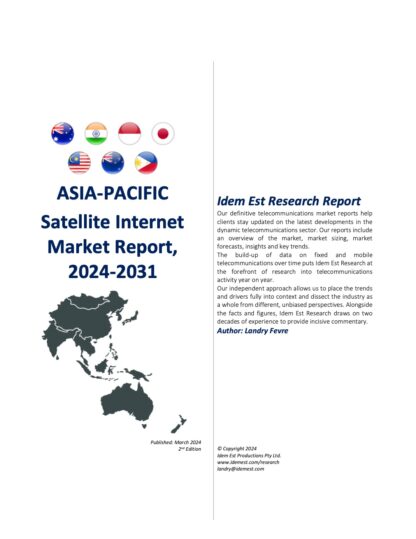Your cart is currently empty!
Bangladesh Telecoms Industry Report – 2024-2031
This report provides analyses of revenue and market forecasts as well as statistics of the Bangladesh telecoms industry including market sizing, 10-year forecasts, market insights, key telecom trends, 5G and also features the following: Overall Telecommunications Market by Major Operators Telco Operators Profile, Revenue and EBITDA Mix Mobile Subscribers & Revenue Market Overview and Forecasts Spectrum Holdings IoT Market Overview Broadband Subscribers & Revenue Market Overview and Forecasts National Broadband Network Detailed Market Overview and Forecasts Thematics / Opportunities relating to 5G, M&A and e-Commerce Telecoms Infrastructure Review Telco M&A Transaction Database About this report: 1st Edition Pages: 76 Author:…
Description
WHY YOU SHOULD BUY THE BANGLADESH TELECOMS INDUSTRY REPORT:
- Benefit from the latest market opportunities
- Understand the threats to your operations and investments and protect your company against future risks
- Gain insights on emerging trends supporting, enhancing or disrupting your activities in the market
- Get a full view of the competitive landscape to assess your market position.
- Forecasts as a key input for successful budgeting and strategic business planning in the telecoms market
- Target business opportunities and risks in the telecoms sector through our reviews of latest industry trends, regulatory changes and major deals, projects and investments
- Assess the activities, strategy and market position of your competitors, partners and clients via our Operators Profiles
The Bangladesh Telecommunications Industry Report, 2024-2031 includes a comprehensive review of the Bengali market dynamics, market sizing, market forecasts, analysis, insights and key trends.
EXECUTIVE SUMMARY
Bangladesh Telecoms Industry Report at a Glance
Bangladesh’s dynamic and understudied telecommunications market is one of the remaining last frontier offering investment opportunities in mobile and fixed digital infrastructure. Although Bangladesh’s greenfield telecom market holds huge potential, opportunities must be viewed in light of real challenges, including a lack of physical supporting infrastructure and stable and reliable power transmission and distribution. Regulatory uncertainties, byzantine licensing and adverse weather events remain a hindrance to fixed and mobile operators as well as towercos to invest further in telecommunications digital infrastructure.
Idem Est Research forecasts that mobile subscriptions will grow and fixed broadband subscribers during over the period 2024-2031. The country will add nearly 55m Internet users by 2031 growing at an annual average rate of 5.9% in the forecast period.
Growing mobile phone penetration and growing fixed broadband take-up among households will fuel future growth over the next eight years. Idem Est Research forecasts that mobile subscriptions will grow at an annual average rate of 2.5% in 2024-31 and fixed broadband subscribers at an average rate of 9.3% over the same period. Internet user penetration will increase at an annual average rate of 12% in the 2024-31 forecast period with an estimated 39% of the population connected to the Internet in 2023 growing to 80.2% by 2031.
Currently, fast Internet in Bangladesh is primarily available in the urban regions in Dhaka and Chittagong. Outside the main cities, the Internet connection in Bangladesh tends to be slow and expensive.
Capex Investments
Expanded coverage, greater affordability, service improvements, increased data usage and smartphone penetration are the main drivers of growth in the telecoms sector. The country continues to expand its fibre-optic network and 4G coverage, backed by increasing investment in capital expenditure. Investments in the telecoms sector grew at an annual average rate of 4.3% in 2017-23. Telecommunications service providers are expected to maintain growth momentum in 2024-31, to an average rate of 6.1%.
Operator Profiles
The Benglai four-player mobile market is a remarkably stable market, however with mobile revenue pressure, all operators are broadening their range of services from e-commerce, smart home to digital payments.
The telecommunications market is dominated by three large mobile operators – Grameephone, Robi and Banglalink – with mobile-only infrastructure competing with the incumbent Bangladesh Telecommunications Company Limited (BTLC) which also operates Teletalk the smallest mobile operator in the country. Other emerging fibre broadband operators, Carnival Internet, DOT Internet, Link3, KS Network, Carnival, Triangle, Optimax, Infobase and Infolink among hundreds remain small, sub-scale and expensive.
Between 2017 and 2023, both both revenue and EBITDA shares remained remarkably stable, with Banglalink losing some share of the telecoms market Revenue & EBITDA following a late 4G upgrade.
Mobile Subscribers and Revenue
Average annual mobile revenue growth was much lower (5.8%) than mobile service subscriptions growth (5.9%) during the period 2017-2023, highlighting a fairly stable market in terms of ARPU for mobile operators. Declining voice & SMS revenue are offset by wireless data monetisation which came late to the market, competitive pressure on ARPU are likely to occur, compounded by bundling discounts to stem churn.
According to our benchmark study of mobile data pricing, Bangladesh had among the biggest cost reduction per GB over the last 3 years, while India has the lowest rate in the world with just a few cents per GB.
The Bengali mobile market is rapidly transforming from a voice and SMS to a mobile data-dominated market. With a continued drive to convert smartphones users to digital shoppers and therefore increasing mobile operators’ consumers share of wallet. Mobile operators are increasing market segmentation and deliver innovative offerings targeting households with digital services such as music, video streaming, digital payments and bundles of other services such as home automation, IPTV and fixed broadband.
Broadband Subscribers – FTTH Push to Gigabit Speeds
After many years of under investments in fibre infrastructure, Bangladesh boasts among the lowest FTTH penetration in the world and among the most fragmented market with mobile operators not playing in the market due to licensing issues. Most people use only 5-10Mbps packages with pricing caps mandated by the regulator.
Fixed broadband penetration is forecasted to grow strongly as Bangladesh’s investments in full-fibre networks are still small in scale with many premises yet to be passed.
Thematics – Telecoms Infrastructure / 5G / M&A / Infrastructure
Infrastructure funds, pension funds and government funds are assigning high valuation multiples to telecommunications infrastructure assets such as mobile towers, data centres, submarine cable and fibre infrastructure.
Investment funds are assigning high valuation multiples to telecommunications infrastructure assets such as mobile towers, data centres, submarine cable and fibre infrastructure. This report outlines some real market examples of how investors view and value these investments with real industry examples and EV/EBITDA comparatives and benchmarks.
Our Bangladesh Telecoms Industry Report transactions database analysis highlights the dearth of inbound (domestic) transactions in the Bangladesh telecommunications services market, with the largest transactions in towercos and small stakes sale down in mobile operators.
The arrival of 4G moved the Internet off our desktops into our palms and pockets, 5G could transform the network from something we carry around to something taking us around either virtually (augmented reality or virtual reality) or in reality (autonomous vehicles), the 5G outcome and benefits beyond fast connectivity remain largely unknown in terms of business models, investments required and timeline.
KEY COMPANIES MENTIONED IN THIS SINGAPORE TELECOMS INDUSTRY REPORT:
Aamra Networks, AB High Tech, ADN Telecom, Banglalink, BDCom, BTCL, BSCC, Carnival, edotco, Frontier Towers Bangladesh, Grameenphone, Kirtonkhola Tower Bangladesh, KTBL, Robi Axiata, Summit Communications, TASC Summit Towers, Teletalk, Triangle
Bangladesh Telecoms Industry Report – Table of Contents
1 Key Statistics
1.1 Bangladesh’s Population & Households
1.2 Bangladesh’s Economy
1.3 Bangladesh’s GDP
2 Overall Telecommunications Market, 2017–2031
2.1 Market Overview
2.2 Historical Telecommunications Market Revenue, 2017-2023
2.3 Overall Telecommunications Market Forecast, 2023-2031
2.4 Telecommunications Market Capital Expenditure, 2017-2031
2.4.1 Historical Telecommunications Capex Spend, 2017-2023
2.4.2 Capex to Revenue Benchmark
2.4.3 Capex to GDP Benchmark
2.4.4 Telecommunications Capex Spend Forecast, 2000-2030
3 Telecommunications Operators Profile
3.1 Grameenphone Profile
3.1.1 Grameenphone Revenue and EBITDA Mix
3.2 Robi Axiata
3.2.1 Robi Axiata Revenue and EBITDA Mix
3.3 Banglalink Profile
3.3.1 Banglalink Revenue and EBITDA Mix
3.4 Teletalk
3.4.1 Teletalk Revenue and EBITDA Mix
3.5 Bangladesh Telecommunications Company Ltd
3.5.1 BTCL Revenue and EBITDA Mix
3.6 Other Players Profile
3.6.1 Carnival Internet
3.6.2 Earth Net
3.6.3 Link3 Telecom
3.6.4 ADN Telecom
3.6.5 Other Broadband Providers
4 Mobile Market
4.1 Mobile Subscribers Historical and Forecast, 2017-2031
4.1.1 Mobile Subscribers Historical, 2017-2023
4.1.2 Mobile Subscribers Market Share, 2017-2023
4.1.3 Bangladesh Smartphone Share, 2023
4.1.4 Bangladesh Mobile Subscribers Forecast, 2023-2031
4.1.5 Bangladesh Mobile Subscribers by Generation Forecast, 2023-2031
4.2 Mobile Revenue Historical and Forecast, 2017-2031
4.2.1 Historical Mobile Revenue, 2017-2023
4.2.1 Mobile Revenue Market Share, 2017-2023
4.2.2 Mobile Revenue Forecast, 2023–2031
4.2.3 Mobile Subscribers ARPU, 2017-2031
4.3 Spectrum Holdings
4.3.1 Existing Spectrum Holdings and 5G Trials
4.3.2 Mobile Frequencies Portfolios Analysis
4.3.1 Spectrum Depth Benchmark by Country
4.4 Mobile Download Data and Pricing Trends
4.5 Mobile Speed Tests
4.5.1 Ookla Mobile Speed Tests
4.5.2 OpenSignal
4.6 Internet of Things (IoT)
5 Broadband Market
5.1 Fixed Broadband Subscribers Historical, 2017-2023
5.2 Fixed Broadband Subscribers Forecast, 2023-2031
6 Satellite Internet Connectivity
6.1 Comparing LEO, MEO, and GEO Satellite Orbits
6.1.1 LEO and GEO Satellite Comparison
6.2 Satellite Broadband Providers Operators, 2023
6.3 5G NTN: The Next Generation of Satellite Connectivity
6.3.1 5G NTN Overview
6.3.2 The Rationale Behind 5G NTN
6.3.3 Technical Aspects of 5G NTN
6.3.4 Potential Applications for 5G NTN
6.3.5 Challenges in Implementation
6.3.6 5G NTN Satellite Providers
6.4 Satellite Internet Market Analysis, 2023-2031
6.4.1 Market Landscape of Satellite Broadband Subscribers, 2023
6.5 Bangladesh Satellite Broadband Subscribers Forecast, 2023-2031
7 Fixed Telecommunications Infrastructure Investments
7.1 Fixed Digital Infrastructure
7.1.1 Domestic Fibre Infrastructure
7.1.2 FTTH – 20m premises to go
7.2 Submarine Cables
8 Bangladesh Telecom Towers Infrastructure Landscape
8.1 Bangladesh Telecom Towers Market Analysis, 2023
8.1.1 Bangladesh Telecom Towers Market Overview
8.1.2 Bangladesh Telecom Towers Background
8.2 Bangladesh Telecom Towers Market Competitive Landscape Comparison
8.2.1 Bangladesh Telecom Towers Market Competitive Landscape Comparison
8.3 Bangladesh Telecom Towers & Rooftops Market Forecast
8.3.1 Bangladesh Telecom Towers Forecast, 2023-2031
8.3.2 Regulatory Considerations
8.4 edotco Profile
8.4.1 edotco Towers Key Performance Indicators
8.5 AB High Tech Profile (Frontier Towers)
8.5.1 Estimated AB High Tech Key Performance Indicators
8.6 TASC Summit Towers Profile
8.6.1 TASC Summit Towers Key Performance Indicators
8.7 Kirtonkhola Tower Bangladesh Ltd Profile
8.7.1 KTBL Towers Key Performance Indicators
9 Thematics / Opportunities
9.1 Consolidation Opportunities
9.2 Diversification Opportunities
9.3 New Telco Operating Model
9.3.1 The Attraction of Infrastructure Multiples
9.4 6G Developments
10 Telco Transaction Database
11 Methodology
12 Copyright Notice
Bangladesh Telecoms Industry Report – List of Figures
Figure 1 – Telco sector revenue as % of GDP in Bangladesh
Figure 2 –Revenue Profile Historical Mix (BDT m), 2017-2023
Figure 3 – Telecommunications Market Revenue, 2023
Figure 4 – Telecommunications Market EBITDA, 2023
Figure 5 – Telecommunications Revenue & EBITDA Share, 2023
Figure 6 – Total Telecoms Market Revenue and Growth Rate (BDT bn), 2023-2031
Figure 7 – Capex to Revenue Benchmark, 2017-2023
Figure 8 – Capex to GDP Ratio Benchmark, 2017-2023
Figure 9 – Telecommunications Capital & Operational Expenditure Spend, 2000-2031
Figure 10 – Grameenphone Revenue Mix – 2017-2023
Figure 11 – Mobile Subscribers Share Comparison, 2017-2023
Figure 12 – Mobile Subscriber Share Comparison, 2017-2023
Figure 13 – Mobile Net Adds (000’s) Comparison, 2017-2023
Figure 14 – Mobile Subscribers Forecast, 2023-2031
Figure 15 – Mobile Subscribers by Generation Forecast, 2023-2031
Figure 16 – Mobile Subscribers Share Comparison, 2017-2023
Figure 17 – Mobile Revenue Forecast, 2023-2031
Figure 18 – Mobile Subscribers ARPU (BDT), 2017-2031
Figure 19 – Subscriptions per MHz of Spectrum, Select Asia-Pacific Countries, 2024
Figure 20 –Mobile Handsets Monthly Download Data, 2017-2023
Figure 21 – Data Pricing Trends in Asia Pacific (USD per GB per Month), 2017-2023
Figure 22 – Asia Pacific Data Pricing Benchmark, 2024
Figure 23 – Spectrum available for IoT in Bangladesh
Figure 24 – Broadband Technology Share Comparison, 2017-2023
Figure 25 – Bangladesh Net-Adds (000’s) by Technology, 2017-2023
Figure 26 – Broadband Subscribers Forecast, 2023-2031
Figure 27 – Satellite Deployments Type
Figure 28 –Starlink and OneWeb Satellite Launches per Month (Data until Jan-24)
Figure 29 – Indonesia Satellite Broadband Subscribers (k) Forecast, 2023-2031
Figure 30 – Bangladesh Telecom Towers Market Share, 2023
Figure 31 – Bangladesh Telecom Towers Forecast, 2023-2031
Figure 32 – Telecoms Providers EV/EBITDA Ranges
Bangladesh Telecoms Industry Report – List of Tables
Table 1 – Bangladesh – Key Statistics
Table 2 – Telecommunications Market Revenue by Operators, 2017-23
Table 3 – Total Telecommunications Market Revenue, 2023-2031
Table 4 – Historical Telecommunications Capex Spend, 2017-2023
Table 5 – Total Telecommunications Capex Investments Forecast, 2023-2031
Table 6 – Historical Grameenphone Revenue & EBITDA, 2017-2023
Table 7 – Robi Axiata Revenue and EBITDA Mix, 2017-2023
Table 8 – Banglalink Revenue and EBITDA Mix, 2017-2023
Table 9 – Teletalk Revenue and EBITDA Mix, 2017-2023
Table 10 – BTCL Revenue and EBITDA Mix, 2017-2023
Table 11 – Historical Mobile Subscribers, 2017-2023
Table 12 – Bangladesh Mobile Subscribers Forecast, 2023-2031
Table 13 – Bangladesh Mobile Subscribers by Generation (2G, 3G, 4G & 5G) Forecast, 2023-2031
Table 14 – Historical Mobile Service Revenue, 2017-2023
Table 15 – Mobile Service Revenue Forecast, 2023-2031
Table 16 – Historical Mobile ARPU, 2017-2023
Table 17 – Spectrum Holdings by Operators and by Bands (MHz)
Table 18 – Mobile Frequencies by Operators and by Band (MHz)
Table 19 – Historical Broadband Subscribers, 2017-2023
Table 20 – Broadband Subscribers Forecast, 2023-2031
Table 21 – Satellite Orbit Altitudes
Table 22 – LEO and GEO Satellite Comparison
Table 23 – Satellite Broadband Subscribers Operators, 2024
Table 24 – 5G NTN and Satellite Providers, 2023
Table 25 – Bangladesh Satellite Broadband Subscribers Forecast, 2023-2031
Table 26 – Estimated Backbone Fibre Length, 2022
Table 27 – International Submarine Cable Systems with Landing Stations in Bangladesh
Table 28 – Bangladesh Telecom Towers Market Analysis, 2023
Table 29 – Bangladesh Tenant Indicative Tower Leasing Monthly Fees
Table 30 – Bangladesh Telecom Towers Market Competitive Landscape Comparison
Table 31 – Bangladesh Telecom Towers, Revenue, Mobile Subscribers, Penetration & ARPU Forecast, 2023-2031
Table 32 – edotco Key Performance Indicators, 2023
Table 33 – AB High Tech Key Performance Indicators, 2023
Table 34 – TASC Summit Towers Key Performance Indicators, 2023
Table 35 – KTBL Towers Key Performance Indicators, 2023
Table 36 – Telco Transaction Database, 2019-2023
Other Idem Est Research Telecoms Country Reports
Australia, Bangladesh, China, India, Indonesia, Japan, New Zealand, Malaysia, Myanmar, Pakistan, Philippines, Singapore, South Korea, Taiwan, Thailand, Vietnam,
Asia Pacific Telecom Towers, Asia Pacific Satellite Internet, Starlink Company Profile
Additional information
| Brand | Idem Est Research |
|---|---|
| Global Identifier | BD1 |





